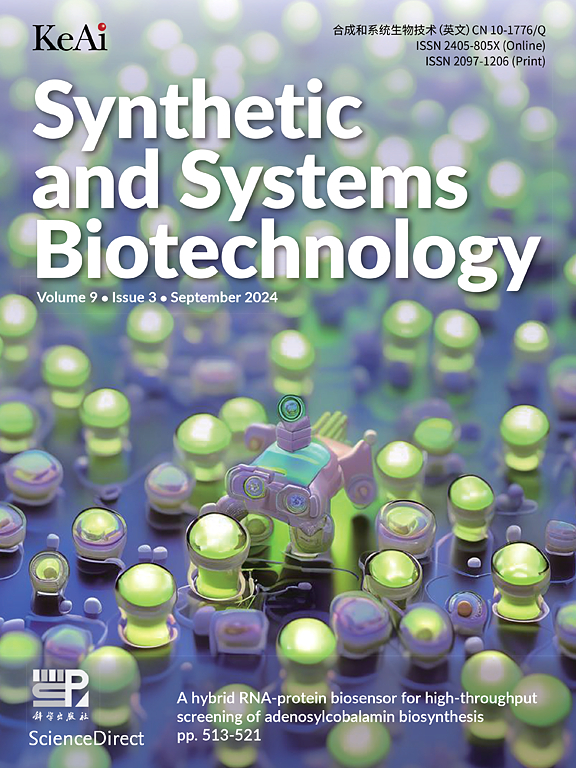Integration of metabolic and evolutionary processes to construct efficient xylose-utilizing strain of Zymomonas mobilis for lignocellulosic ethanol production
IF 4.4
2区 生物学
Q1 BIOTECHNOLOGY & APPLIED MICROBIOLOGY
引用次数: 0
Abstract
Xylose is a major component of lignocellulose, and it is crucial to enable microorganisms the capability of efficient xylose utilization for economical lignocellulosic biochemical production. Zymomonas mobilis is a natural ethanologenic bacterium with xylose-utilizing recombinant strains engineered for commercial lignocellulosic ethanol production. However, low efficiency of xylose utilization is still the major hurdle for lignocellulosic biochemical production, especially in the lignocellulosic hydrolysate containing inhibitory compounds and mixed sugars of glucose and xylose. In this study, xylose-utilization capability of a xylose-utilizing recombinant strain 8b-S38 of Z. mobilis was further improved by evaluating the effects of different xylose metabolic pathways, xylose isomerases, and xylose transporters. The results demonstrated that xylose isomerase pathway is still the most efficient one in Z. mobilis among the xylose metabolic pathways examined, and the introduction of xylose isomerase (XI) such as StrXI and PanXI to increase its copy numbers can improve xylose utilization. In addition, the introduction of effective xylose transporter such as high-affinity xylose transporter XylFGH and the glucose facilitator mutant GlfA165M−K458I promoted xylose transportation and subsequent utilization. A recombinant strain S67SPGlfm was constructed combining rational engineering of xylose isomerases and transporters and semi-rational adaptation, which exhibited enhanced xylose utilization capability in lignocellulosic hydrolysate. This study illustrated that the construction of robust and efficient industrial strains with complex phenotypes requires a combination of different strategies such as metabolic engineering and adaptive laboratory evolution, which also provided biological parts such as xylose isomerases and xylose transporters to help design and construct microbial cell factories for efficient xylose utilization in the future.

整合代谢和进化过程构建高效木糖利用菌株生产木质纤维素乙醇
木糖是木质纤维素的主要成分,因此使微生物具备高效利用木糖的能力对经济的木质纤维素生化生产至关重要。Zymomonas mobilis 是一种天然乙醇菌,其木糖利用重组菌株可用于商业木质纤维素乙醇生产。然而,木糖利用效率低仍然是木质纤维素生化生产的主要障碍,尤其是在木质纤维素水解物含有抑制性化合物和葡萄糖与木糖混合糖的情况下。本研究通过评估不同木糖代谢途径、木糖异构酶和木糖转运体的影响,进一步提高了木糖利用重组菌株 8b-S38 的木糖利用能力。结果表明,在所研究的木糖代谢途径中,木糖异构酶途径仍然是Z. mobilis最有效的途径,引入木糖异构酶(XI),如StrXI和PanXI,增加其拷贝数,可以提高木糖的利用率。此外,引入有效的木糖转运体,如高亲和性木糖转运体 XylFGH 和葡萄糖促进剂突变体 GlfA165M-K458I 可促进木糖的转运和后续利用。结合木糖异构酶和转运体的合理工程设计以及半合理适应,构建了重组菌株 S67SPGlfm,该菌株在木质纤维素水解物中表现出更强的木糖利用能力。这项研究表明,要构建具有复杂表型的稳健高效的工业菌株,需要将代谢工程和适应性实验室进化等不同策略结合起来,同时还提供了木糖异构酶和木糖转运体等生物部件,有助于未来设计和构建高效利用木糖的微生物细胞工厂。
本文章由计算机程序翻译,如有差异,请以英文原文为准。
求助全文
约1分钟内获得全文
求助全文
来源期刊

Synthetic and Systems Biotechnology
BIOTECHNOLOGY & APPLIED MICROBIOLOGY-
CiteScore
6.90
自引率
12.50%
发文量
90
审稿时长
67 days
期刊介绍:
Synthetic and Systems Biotechnology aims to promote the communication of original research in synthetic and systems biology, with strong emphasis on applications towards biotechnology. This journal is a quarterly peer-reviewed journal led by Editor-in-Chief Lixin Zhang. The journal publishes high-quality research; focusing on integrative approaches to enable the understanding and design of biological systems, and research to develop the application of systems and synthetic biology to natural systems. This journal will publish Articles, Short notes, Methods, Mini Reviews, Commentary and Conference reviews.
 求助内容:
求助内容: 应助结果提醒方式:
应助结果提醒方式:


